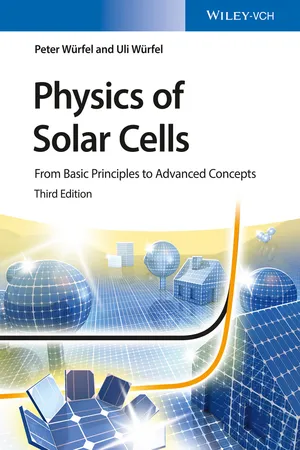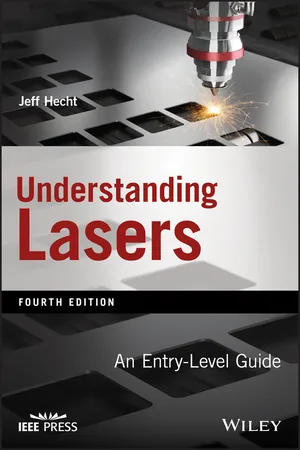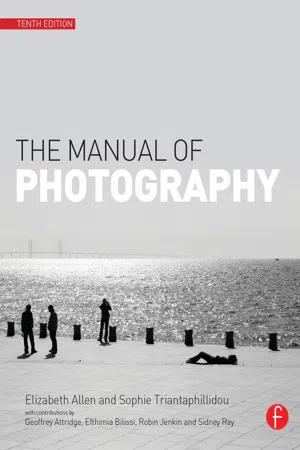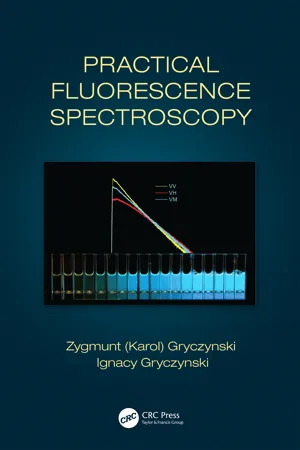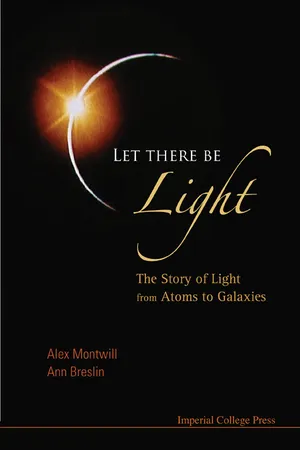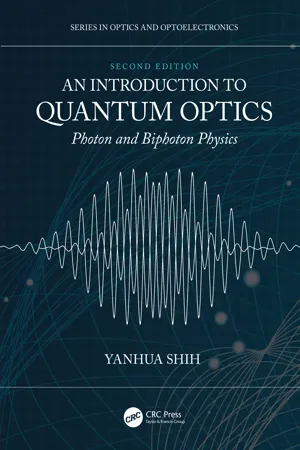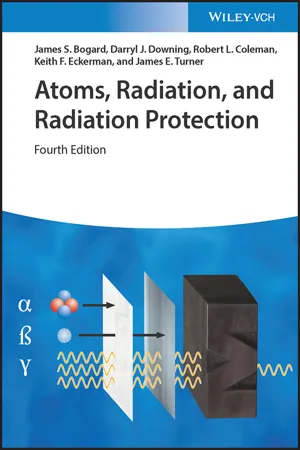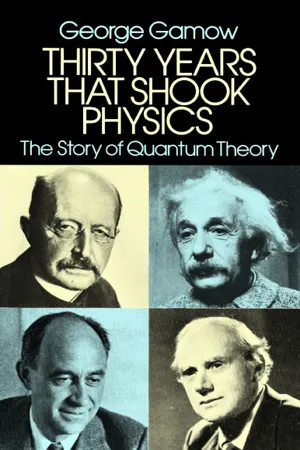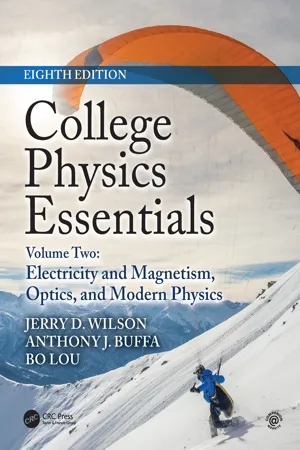Physics
Energy of a Photon
The energy of a photon refers to the amount of energy carried by a single photon, which is a quantum of electromagnetic radiation. It is directly proportional to the frequency of the photon, as described by the equation E=hf, where E is the energy, h is Planck's constant, and f is the frequency. This concept is fundamental in understanding the behavior of light and other forms of electromagnetic radiation.
Written by Perlego with AI-assistance
Related key terms
Related key terms
1 of 4
Related key terms
1 of 3
12 Key excerpts on "Energy of a Photon"
- eBook - ePub
From Atoms to Higgs Bosons
Voyages in Quasi-Spacetime
- Chary Rangacharyulu, Christopher J. A. Polachic, Chary Rangacharyulu, Christopher J. A. Polachic(Authors)
- 2019(Publication Date)
- Jenny Stanford Publishing(Publisher)
9 but in which no explanation is forthcoming for its emission and absorption in matter.The concept of the photon, as a discrete energy entity or packet of light, is not very different from that of Isaac Newton, who imagined light to be made up of corpuscular bullets. But in classical Newtonian thinking, there was no association between the frequency of light and its energy. In the quantum concept, this is a chief characteristic of light: the Energy of a Photon isE = h v (9.2)as originally given by Planck, where h is a constant of Nature. The frequency parameter for light (v ) is a continuous variable, and so is the energy that a photon may have.9.3 Waves and Particles, Real and Virtual
Until very recently, photons occupied a unique status in particle physics. A “free” photon has zero mass, which makes the energy and momentum numerically the same value. We would recognize this as a kinetic momentum . Another kind of momentum, the canonical momentum , is defined for a photon that is not free, but present within a material medium. As photons propagate in media, they may exert a push or pull on the material, which can be modeled as an effective mass for the photon. In this context, the canonical momentum is sensitive to the electromagnetic properties of the medium in which the photon is moving.Maxwell’s theory of electromagnetism, combined with the spacetime concepts of Einstein’s relativity as a basic premise, yields a body of theory called electrodynamics . Early developments in quantum theory incorporated photons as waves, with quantum mechanical representations for the material bodies with which photons might interact. Photon-matter scattering was described very well by the Klein–Nishina formula , which treats photons as monochromatic waves of well-defined energy. Following the development of quantum electrodynamics (QED), theorists checked that new theory to see if it agreed with the successful Klein–Nishina formula, although the concept of radiation is ontologically very different in the two frameworks. In QED, matter particles and photons do not move in space. Rather, when a photon’s position changes from point A to point B, we mathematically destroy one photon at point A and create another at point B.10 This QED process does not obey the principle of causality and leaves the physical system in an energetically unphysical state for a short time interval—an acceptable situation if we invoke Heisenberg’s uncertainty relations. An example of this kind of scenario is the well-known Compton scattering - Bill Woodward(Author)
- 2014(Publication Date)
- Sybex(Publisher)
photon, it travels in a wavelike pattern moving at the speed of light.A photon, which is emitted from an electron as it changes energy levels, is the basic unit, or quantum, of electromagnetic energy. The amount of energy in each photon, however, depends on the electromagnetic energy's frequency: the higher the frequency, the more energy in the particle.To express the amount of energy in a photon, we use the equation- E = hf
where E is the energy expressed in watts, h is Planck's constant, or 6.626 × 10-34 joule-seconds, and f is the frequency of the electromagnetic energy.So, to find the Energy of a Photon of infrared light at 229 THz- (2.29 × 1014 )(6.626 × 10-34 ) = 1.517 × 10-19 W
Much of what we take for granted in the field of fiber optics comes from work done by pioneers in the field of physics in the late 1800s and early 1900s. The joule is a unit of energy named for James Prescott Joule, who studied the relationship between heat and mechanical work. One joule is equal to the amount of work required to produce 1 watt in 1 second. Planck's constant was defined in 1899 by Nobel Laureate Max Planck, who is regarded as the founder of quantum theory.The Electromagnetic Spectrum
In 1964, scientists at a Bell Laboratories facility in New Jersey accidentally discovered electromagnetic radiation associated with the very beginnings of our universe. The radiation, predicted by certain cosmological theories, was emitted by hydrogen atoms at a temperature of just about 3° on the Kelvin- eBook - ePub
Physics of Solar Cells
From Basic Principles to Advanced Concepts
- Peter Würfel, Uli Würfel(Authors)
- 2016(Publication Date)
- Wiley-VCH(Publisher)
Chapter 2 PhotonsPhotons are particles of light. Photons to which the human eye reacts, that is, those that we see, have energies ћω between 1.5 and 3 eV. They always move with the velocity of light, in a vacuum with a velocity of c0 = 3 × 108 m s−1 , and in a medium with refractive index n with a velocity of c = c0 n. The fact that we can also describe light as an electromagnetic wave is in no way contradictory. The square of the field strength of the electromagnetic wave describes the location of the photons. In contrast to the behavior familiar from shot pellets, photons obey the laws of quantum mechanics and not those of the more common Newtonian mechanics. The differences from Newtonian mechanics become apparent only for particles of very low energy (including the mass). Since it is difficult to visualize particles that do not move along a straight line, in a dualistic approach the wave property is generally invoked to describe diffraction and interference phenomena and the particle property is used to describe the quantumlike transport of energy, as in this book.2.1 Black-body Radiation
A black body is defined as a body that completely absorbs radiation of all photon energies ћω. Its absorptance is2.1A possible example of a black body is a tiny hole in a cavity. Photons incident on the hole are not reflected, but are absorbed inside the cavity. The hole is described as black, because it appears black when the inner part of the cavity is at a low temperature and very few photons are emitted by the walls of the cavity. When the inner part is at a high temperature, the cavity is like a furnace. We then see a very bright hole, through which we can view the interior of the furnace. Nevertheless, regardless of whether it emits radiation, the hole absorbs all incident radiation and is therefore still described as a black body. - eBook - ePub
Understanding Lasers
An Entry-Level Guide
- Jeff Hecht(Author)
- 2018(Publication Date)
- Wiley-IEEE Press(Publisher)
–34 joule-second, so photon energy is(2.4)The frequency ν is measured in waves per second, so multiplying it by the number of waves (sometimes called cycles) gives energy per photon in the same joule-second units as Planck's constant.You can use this formula and the relationship between wavelength and frequency to show that wavelength times photon energy equals Planck's constant multiplied by the speed of light c, or 1.99 × 10–25 joule-meter:(2.5)You may need these conversion factors from time to time when you work with light and other electromagnetic waves, so they are listed in Appendix B. For now, the most important lesson is that the nature of a light wave can be measured in three ways: photon energy, wavelength, or frequency. For example, light with a 1-μm wavelength roughly has a frequency of 3 × 1014 Hz, and photon energy of 2 × 10–19 joule.Physicists often measure photon energy in electron volts, the energy an electron acquires by moving through a one-volt potential. One electron volt equals 1.6022 × 10–19 joule, so a photon energy of 2 × 10–19 joule equals 1.24 electron volts, a more convenient unit of measurement.It is easy to make mistakes in converting units, so it helps to remember these simple rules of thumb:- The higher the frequency, the shorter the wavelength.
- The higher the frequency, the larger the photon energy.
- The shorter the wavelength, the larger the photon energy.
Electromagnetic waves are often called electromagnetic radiation because objects emit or radiate - eBook - ePub
- Elizabeth Allen, Sophie Triantaphillidou(Authors)
- 2012(Publication Date)
- Routledge(Publisher)
Photons differ from other elementary particles such as electrons in that they have zero mass or electric charge and consist purely of energy. When many photons are present, for example in a light beam, their numbers are so large that the inherent discontinuity or granularity of the light beam disappears and it appears as a continuous phenomenon. The photon can exhibit wave-like behaviour, resulting in phenomena such as refraction or diffraction, described earlier in this chapter. It also behaves as a particle when interacting with matter at a subatomic level, exchanging energy in discrete amounts. The amount of energy E (from Planck’s Law) exchanged during such an interaction is dependent on the frequency of light, and is known as the photon energy. This relationship may be rewritten in terms of the wavelength of the light: where c is the speed of light, h is Planck’s constant, v is the frequency and λ is the wavelength. This means that shorter wavelengths of light will have higher photon energy (see Figure 2.23, which shows the electromagnetic spectrum in terms of wavelength, frequency and photon energy). This becomes important later on, in understanding why imaging materials are sensitive to some wavelengths of light and not others (spectral sensitivity). BOHR MODEL OF THE ATOM In the early twentieth century, the commonly accepted model of the atom was the planetary model of Rutherford in 1911 (Figure 2.29), which consisted of a small densely packed positively charged nucleus, made up of protons and neutrons, about which clouds of negative electrons orbited, like planets around the sun. Rutherford’s model assumed that some outer electrons were loosely bound to the nucleus and could therefore be easily removed by applying energy. There is a problem with this model, however, as follows: the negative charge of the nucleus and the positive charge of the electrons mean that there is an electrostatic attraction between them - Andreas Braeuer(Author)
- 2015(Publication Date)
- Elsevier(Publisher)
We will see later that in spectroscopy waves are usually characterised by providing information about their wavenumber or their frequency. This is due to the fact that the wavenumbers and frequencies scale linearly with the energy of one wave, while the energy of one wave and the wavelength follow a non-linear behaviour. Nevertheless it has to be mentioned—and we will see it in the subsequent section—that the most accurate way of characterising a wave is providing its frequency, as the frequency of the oscillation remains constant when the electric field propagates through different media of different indices of refraction, while the wavelength and with this the wavenumber of the wave would change. Nevertheless, in spectroscopy wavenumbers and wavelengths are more frequently used than frequencies.2.1.4. Energy and Momentum of a Photon
Some interaction mechanisms between matter and electromagnetic radiation are much easier to describe and to understand if the ‘electromagnetic radiation’ is replaced by ‘photons’. It is well known that some interaction mechanisms between matter and light can be described best by considering light to be a wave and others by considering light to be composed of photons. This duality between the wave and the photon properties of light is termed wave–particle duality. Both theories are required to explain all phenomena of light–matter interaction. The diffraction of light on a slit, for example, can be described considering light to be a wave. The fact that light carries momentum can be described by considering light to be composed of photons. Even for the computation of the energy of one photonE Photon= h ⋅ ν = h ⋅c λ(2.9)properties characteristic for a wave, such as its frequency ν or its wavelength λ are required. Here h is the Planck’s constant. Eqn (2.9) shows that the energy of one photon does linearly follow the frequency ν or the wavenumberAlso for the computation of the momentum of one photonof the corresponding wave but that there is a non-linearν ¯= 1 / λ1 / λ-dependency between the photon energy and the wavelength of the corresponding wave. This dependency explains why in spectroscopy waves are characterised by either considering frequencies or wavenumbers.p Photon==E Photonch λ(2.10)properties characteristic of a wave are required.Figure 2.7 shows the normalised energy of photons emitted by common lasers available between the ultraviolet (UV) over the visible (VIS) and the infrared (IR) spectral region as a function of the wavelengths of the corresponding waves. The energy of the photons E Photon is normalised to the energy of one photon emitted by an excimer (excited dimer), laser filled with a gas mixture of krypton, fluorine and helium. Therefore this laser is called KrF-excimer laser. One clearly can see that the photon energy E Photon shows a1 / λ- eBook - ePub
- Zygmunt (Karol) Gryczynski, Ignacy Gryczynski(Authors)
- 2019(Publication Date)
- CRC Press(Publisher)
CHAPTER 1Theory of Light and Light Interaction with Matter
C ONVENTIONALLY, WE CALL “LIGHT ” a small range of a broad spectrum of electromagnetic radiation that corresponds to the visible spectral range (400–700 nm) as shown in Figure 1.1 . Light is electromagnetic radiation which presents properties of both a wave and a particle. A “particle” of light is called a photon. The dual nature of light is often a source of confusion, but experiments confirming both interpretations exist. For example, experiments involving single-photon double-slit interference and the photoelectric effect have shown both the wave and particle nature of light, respectively. A photon is a quanta or the smallest possible amount/part of an electromagnetic energy/wave. Since we almost always refer to multiple photons, a photon can be referred to as a quantum of electromagnetic radiation. Both definitions will be used throughout this text. For example, a single chromophore (molecule) absorbs or emits a photon of a certain energy. It is important to remember that when discussing photons or electromagnetic waves, we are talking about light; both representations are equivalent, but one is often much easier applied to a particular scenario. For example, it is more natural to discuss a metal interacting with an oscillating electric wave rather than a stream of “particles” (photons) that never physically collide with the metal surface.FIGURE 1.1 Electromagnetic radiation. The expanded range of 400–700 nm represents visible light.1-1 BASICS OF LIGHT
This section is meant as a review of the basics of light as electromagnetic waves or photons. More importantly, it should demonstrate that there are many different ways of looking at light from a mathematical perspective, but they all lead to the same interpretation. Various uses of light are presented across many different fields, especially biology, chemistry, physics, and engineering. Within each field, and indeed specializations within each individual field, the nomenclature and properties of interest vary. For example, in biology, spectra are frequently given in a wavelength scale (nanometers) but in the semiconductor field, they are typically presented on a scale in terms of energy (electron volts). However, any spectrum may be presented in wavelength or energy without a loss of information. By the end of this chapter, the reader should have a fluid understanding of the relationships between different notations. - eBook - ePub
Let There Be Light
The Story of Light from Atoms to Galaxies
- Alex Montwill, Ann Breslin(Authors)
- 2008(Publication Date)
- ICP(Publisher)
Chapter 13Atoms of Light Acting as Particles
The energy of light comes in quantum units of value hf. In this chapter we go a step further, and look at evidence that it comes as a bundle, concentrated at a point, and behaves just like a particle. We will describe experiments that show that the photon has not only energy but also momentum.First, we will show that the photon can behave like a bullet causing considerable disruption to surfaces of materials, particularly metals, whose atoms have ‘loose’ outer orbit electrons which are vulnerable to such bombardment. In the photoelectric effect an electron is knocked out from the surface of a metal by a photon. Because this happens instantaneously, and from the energy of the ejected electron, we can deduce that the collision is a ‘one-on-one’ encounter. There are many practical applications; we can use the photoelectric effect, whenever we want to translate a light signal into an electric current.Next, we will look at an experiment which demonstrates that the photon has another characteristic of a particle, namely momentum. In the Compton effect the photon bounces off an electron, and the two then go off at different angles. We can apply the laws of conservation of energy and momentum to calculate angles and energies just as we do for a collision on a snooker table. In this experiment we look at the photon after it has been scattered in the collision.There is one interesting difference between a scattered photon and a scattered snooker ball. The photon cannot slow down; and always travels at the speed of light. It loses energy and momentum by decreasing its frequency and correspondingly increasing its wavelength, without changing its speed. The exact way in which this should happen is calculated in Appendix 13.1 - eBook - ePub
An Introduction to Quantum Optics
Photon and Biphoton Physics
- Yanhua Shih(Author)
- 2020(Publication Date)
- CRC Press(Publisher)
ℏω must be carried by the wavefront of the subfield and thus uniformly distributed on the big sphere. Einstein then asked again: suppose that photon is annihilated by a point-like photon counting detector located on the surface of the big sphere, how long does it take for the energy on the other side of the big sphere to arrive at the detector? Two years? Bohr provided a famous answer to this question: the “wavefunction collapses” instantaneously! Why does the wavefunction need to “collapse”? Bohr did not explain. Nevertheless, Bohr has passed an important message to us: quantum mechanical picture of photon is different from Einstein’s granularity, or EM subfield. Although we still have questions regarding the wave-particle duality of a photon, we have to accept the experimental effect that the energy of the electromagnetic field is quantized in nature. We may have to face the truth that a new theory of radiation with quantization is necessary.2.4 FIELD QUANTIZATION AND THE LIGHT QUANTUMIn blackbody radiation, the atoms on the walls of the cavity box continuously radiate electromagnetic waves into the cavity. In general, there are two fundamental principles governing the physical process of the radiation and determining the physical properties of the radiation field. The Schrödinger equation determines the quantized atomic energy level, and the govern the behavior of the radiation field. The interaction between the field and the atom results in a quantized electromagnetic field. The energy and the frequency of the emitted photon are determined by the quantized energy levels of the atom, ℏω = E2 − E1 . On the other hand, any excited electromagnetic field must satisfy the Maxwell equations which determine the harmonic mode structure and the superposition.In the quantum theory of light, the radiation field is treated as a set of harmonic oscillators. The energy of each mode is quantized in a similar way as that of a harmonic oscillator. To quantize the field, we will follow the standard procedure. First, we proceed to link the Hamiltonian of the free electromagnetic field to a set of independent harmonic oscillators. The quantum mechanical results of harmonic oscillators are then adapted to the quantized radiation field. Notice, here, free field means no “sources” or “drains” of the radiation field in the chosen volume of V = L3 that covers the field of interest. The energy of the free field is given byH =(2.4.1)1 2,∫ Vd 3r[]ϵ 0E 2(+r , t)1μ 0B 2(r , t)where V is the total volume of the field of interest. The volume is usually, but not necessarily, treated as a large finite cubic cavity of L - eBook - ePub
- James S. Bogard, Darryl J. Downing, Robert L. Coleman, Keith F. Eckerman, James E. Turner(Authors)
- 2022(Publication Date)
- Wiley-VCH(Publisher)
8 Interaction of Photons with Matter8.1 Interaction Mechanisms
Unlike charged particles, photons are electrically neutral and do not steadily lose energy as they penetrate matter. Instead, they can travel some distance before interacting with an atom. How far a given photon will penetrate is governed statistically by a probability of interaction per unit distance traveled, which depends on the specific medium traversed and on the photon energy. When the photon interacts, it might be absorbed and disappear or it might be scattered, changing its direction of travel, with or without loss of energy.Thomson and Raleigh scattering are two processes by which photons interact with matter without appreciable transfer of energy. In Thomson scattering an electron, assumed to be free, oscillates classically in response to the electric vector of a passing electromagnetic wave. The oscillating electron promptly emits radiation (photons) of the same frequency as the incident wave. The net effect of Thomson scattering, which is elastic, is the redirection of some incident photons with no transfer of energy to the medium. In the modern, quantum-mechanical theory of photon–electron interactions, Thomson scattering represents the low-energy limit of Compton scattering, as the incident photon energy approaches zero.Raleigh scattering of a photon results from the combined, coherent action of an atom as a whole. The scattering angle is usually very small. There is no appreciable loss of energy by the photon to the atom, which, however, does “recoil” enough to conserve momentum. We shall not consider Thomson or Raleigh scattering further.The principal mechanisms of energy deposition by photons in matter are photoelectric absorption, Compton scattering, pair production, and photonuclear reactions. We treat these processes in some detail.8.2 Photoelectric Effect
The ejection of electrons from a surface as a result of light absorption is called the photoelectric effect. The arrangement in Fig. 8.1 can be used to study this process experimentally. Monochromatic light passes into an evacuated glass tube through a quartz window (which allows ultraviolet light to be used) and strikes an electrode 1 causing photoelectrons to be ejected. Electrode 1 can be made of a metal to be studied or have its surface covered with such a metal. The current I that flows during illumination can be measured as a function of the variable potential difference V21 applied between the two electrodes, 1 and 2, of the tube. Curves (a) and (b) represent data obtained at two different intensities of the incident light. With the surface illuminated, there will be some current even with V21 = 0. When V21 - eBook - ePub
Thirty Years that Shook Physics
The Story of Quantum Theory
- George Gamow(Author)
- 2012(Publication Date)
- Dover Publications(Publisher)
These well-established facts could not be explained on the basis of the classical theory of light; in some points they even contradicted it. Light is known to be short electromagnetic waves, and the increase of intensity of light must mean an increase of the oscillating electric and magnetic forces propagating through space. Since the electrons apparently are ejected from the metal by the action of electric force, their energy should increase with the increase of light intensity, instead of remaining constant as it does. Also, in the classical electromagnetic theory of light, there was no reason to expect a linear dependence of the energy of photoelectrons on the frequency of the incident light.Using Planck’s idea of light quanta and assuming the reality of their existence as independent energy packages flying through space, Einstein was able to give a perfect explanation of both empirical laws of photoelectric effect. He visualized the elementary act of the photoelectric effect as the result of a collision between a single incident light quantum and one of the conductivity electrons carrying electric current in the metal. In this collision the light quantum vanishes, giving its entire energy to the conductivity electron at the metallic surface. But, in order to cross the surface and to get into the free space, the electron must spend a certain amount of energy disengaging itself from the attraction of metallic ions. This energy, known by the somewhat misleading name of “work function,” is different for different metals and is usually denoted by a symbol W. Thus, the kinetic energy K with which a photoelectron gets out of the metal is:where v0 is the critical frequency of light below which the photoelectric effect does not occur. This picture explains at once the two laws derived from experiment. If the frequency of the incident light is kept constant, the energy content of each quantum remains the same, and the increase of light intensity results only in the corresponding increase of the number of light quanta. Thus more photoelectrons are ejected, each of them with the same energy as before. The formula giving K as the function of v explains the empirical graphs shown in Fig. 7b , predicting that the slope of the line should be the same for all metals having a numerical value equal to h - eBook - ePub
College Physics Essentials, Eighth Edition
Electricity and Magnetism, Optics, Modern Physics (Volume Two)
- Jerry D. Wilson, Anthony J. Buffa, Bo Lou(Authors)
- 2019(Publication Date)
- CRC Press(Publisher)
n.An electron generally does not remain in an excited state for long; it decays, or makes a downward transition to a lower energy level, in a very short time. The time an electron spends in an excited state is called the lifetime of that state and typically has a value on the order of nanoseconds or less. In making a transition to a lower state, the atom emits a quantum of light energy in the form of a photon. The energy Δ E of the photon is equal in magnitude to the energy difference of the levels. So for the hydrogen atom this isor, more compactly,Δ E =|=|E−n iEn f(−)eV− 13.6n i 2()eV− 13.6n f 2Δ E = 13.6[eV (hydrogen photon energies)]1−n f 21n i 2(27.17) where the subscripts i and f refer to initial and final states, respectively. According to the Bohr theory, this energy difference is emitted as a photon with an energy E. This idea can be used to determine the wavelength of the emitted light: E = Δ E = hc /λ therefore λ = hc /Δ E . Because photon energies are discrete, in the wave model this means that only particular wavelengths of light are emitted. These particular and unique wavelengths correspond to the various transitions between energy levels and thus explain the existence of an emission spectrum.The final principal quantum number n f refers to the energy level at which the electron ends up after the emission process. The original Balmer series (the wavelengths in the visible region) corresponds to n f = 2 and n i = 3, 4, 5, and 6. There is only one emission series entirely in the ultraviolet range, called the Lyman series , in which all the transitions end in the n f = 1 ground state. There are many series entirely in the infrared region, most notably the Paschen series , which ends with the electron in the second excited state, n f = 3. (These series take their names from their discoverers.) See ▼ Figure 27.9
Index pages curate the most relevant extracts from our library of academic textbooks. They’ve been created using an in-house natural language model (NLM), each adding context and meaning to key research topics.
Explore more topic indexes
Explore more topic indexes
1 of 6
Explore more topic indexes
1 of 4


